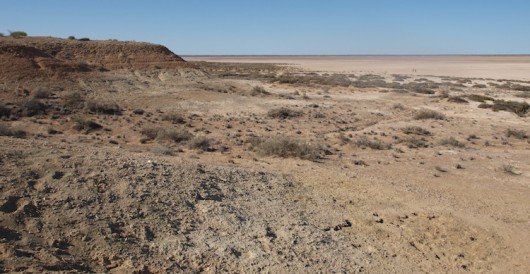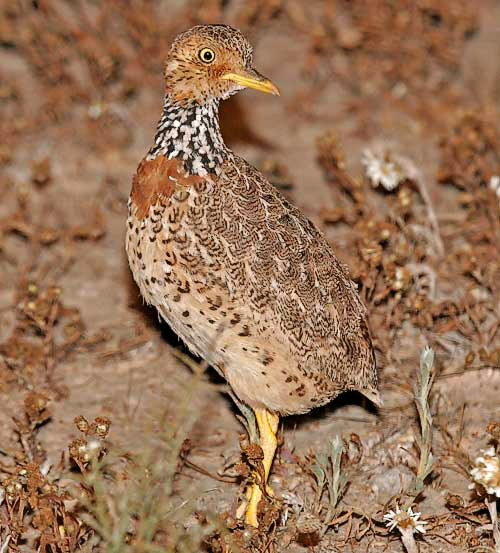Although only one living species of the Australian endemic Plains-wanderer is known, the fossil record has revealed that the lineage already existed on the continent 26 million years ago. But at that time it wasn’t wandering the plains.
LINKED PAPER
A Plains-wanderer (Pedionomidae) that did not wander plains: a new species from the Oligocene of South Australia. De Pietri, V.L., Camens, A.B., & Worthy, T.H. IBIS. DOI: 10.1111/ibi.12215
Australia has more endemic vertebrate species than any other continent, with this endemism extending to entire families of birds. This high degree of endemism has arisen through geographic isolation of the continent from about 50 to 15 million years ago, which has allowed Australia’s iconic fauna to evolve and persist over time. Australia’s fossil record reveals a long history of mammalian evolution, with the majority of modern marsupial families having become established during the early-mid Oligocene (ca. 34–28 million years ago), but we know very little about the evolutionary history of Australia’s native birds.
The Plains-wanderer Pedionomus torquatus is one of Australia’s endemic birds, and up until now, it has been the only species known in its family, the Pedionomidae. Despite its quail-like appearance, the Plains-wanderer actually belongs to the same group as shorebirds, the Charadriiformes. Its superficial similarity to buttonquails led previous authors to propose a close relationship between the two, but more recent studies based on morphological and molecular data revealed it is most closely related to the South American seedsnipes (Olson & Steadman 1981, Baker et al. 2007, Mayr 2011, Gibson & Baker 2012).
Today the Plains-wanderer inhabits sparse open native grasslands of southern and eastern Australia, and does not occur in dense grasslands or treed areas. Unlike most other charadriiform birds, the Plains-wanderer is a very reluctant flier, and more likely to run away or lie flat on the ground when threatened (Baker-Gabb 1996). These native grasslands are therefore inherent to the survival of this bird, as its movement is less restricted when escaping predators (Marchant & Higgins 1993).
The evolutionary history of the Plains-wanderer is poorly understood. Its fossil record only extends back a couple of million years. However, our study demonstrates that another representative of the Plains-wanderer family was indeed present in Australia in the Late Oligocene, extending their fossil record by around 22 million years. Our contribution is based on a fossil coracoid, a bone from the pectoral girdle (Figure 1), which is highly diagnostic within charadriiform birds, and its morphology is tightly linked to flight. We named this pedionomid Oligonomus milleri, alluding to “Oligocene” and “Pedionomus”, and in honour of American ornithologist Alden Holmes Miller (1906–1965), who took part in fossil collecting expedition in South Australia in the early 1960s.

The fossil was found at Lake Palankarinna (Figure 2), a site that has contributed much to our understanding of how the modern Australian fauna evolved. It was collected in 1984 by a team led by Neville Pledge from the South Australian Museum. The bone was found at Steve’s Site on the western side of Lake Palankarinna (eastern Lake Eyre Basin, northern South Australia), within the Etadunna Formation. These deposits have revealed remarkable fossils including early relatives of koalas, kangaroos, possums, wombats and flamingos, the platypus Obdurodon insignis, and many extinct families that are unlike anything still living in Australia today (Rich 1991), such as the large quadrupedal diprotodontids.

Our findings have important implications for avian palaeontology in Australia. Not only do we now have evidence of this lineage being present since at least the Late Oligocene, paralleling the evolutionary history of marsupials in Australia, but we were also able to draw paleoenvironmental, biological, and historical biogeographic conclusions.
This exciting new find indicates that for at least 26 million years, this lineage evolved in Australia, and that it must have split from its closest relatives, the South American seedsnipes, before the Late Oligocene. The presence of a pedionomid in the Late Oligocene of Australia strengthens the possibility of a Gondwanan origin for the shared ancestor of seedsnipes and the Plains-wanderer. South America and Australia were connected via Antarctica up until about 50 million years ago (Bijl et al. 2013). Testing this hypothesis however requires knowledge on terrestrial vertebrate fossils from the Cenozoic of Antarctica, which are extremely scarce and associated with marine deposits (Stilwell & Long 2011).
Nevertheless we found that Oligonomus milleri and the living Plains-wanderer were ecologically very different birds. The fossil pedionomid appears to have been better adapted for flight than its living relative. The plant fossil record further indicates that this region of South Australia was forested when O. milleri was around. It is interesting to note that living seedsnipes also show a preference for grasslands (but also alpine habitats). Intriguingly, our findings indicate that this preference is not ancestral as previously proposed, but evolved separately in both lineages.
Grasslands spread across Australia from the Late Miocene (ca. 11–7 Ma) onwards. The transition from more closed habitats to drier, more open habitats is also chronicled in the fossil record of Australian marsupials. The first wombats with ever-growing teeth adapted to grazing appear in the Middle to Late Miocene (Archer et al. 1995) and the expansion and diversification of kangaroos throughout the Late Miocene and Early Pliocene has also been linked to these changes in vegetation (Prideaux 2004).
Representatives of other Australian and Australasian endemic bird lineages have been found within the Late Oligocene deposits of the Etadunna Formation (Rich 1991), indicating their long-standing presence in Australia. These include Emu relatives (Boles 2001) and the smallest known megapode or incubator bird (Boles & Ivison 2009). Flamingos and flamingo-like birds have also been reported (Miller 1963, Baird & Vickers-Rich 1998), as well as the earliest known darter (Worthy 2012), a rail (Worthy & Boles 2011), cormorants (Worthy 2011), and many species of ducks (Worthy 2009). There is also undescribed fossil material of shorebirds, parrots, pigeons, falcons, and songbirds, so stay tuned for our upcoming contributions on this front.
References
Archer, M., Hand, S. & Godthelp, H. 1995. Tertiary environmental and biotic change in Australia. Paleoclimate and evolution, with emphasis on human origins: 77-90.
Baird, R. F., & Vickers-Rich, P. 1998. Palaelodus (Aves: Palaelodidae) from the middle to late Cainozoic of Australia. Alcheringa 22: 135-151.
Baker, A.J., Pereira, S.L., & Paton, T.A. 2007. Phylogenetic relationships and divergence times of Charadriiformes genera: multigene evidence for the Cretaceous origin of at least 14 clades of shorebirds. Biol. Lett. 3: 205–209
Baker-Gabb, D.J. 1996. Family Pedionomidae. In del Hoyo, J., Elliott, J.A. & Sargatal, J. (eds) Handbook of birds of the world, Vol. 3. Barcelona: Lynx Edicions.
Bijl, P.K., Bendle, J.A., Bohaty, S.M., Pross, J., Schouten, S., Tauxe, L., Stickley, C.E., McKay, R.M., Röhl, U., Olney, M., Sluijs, A., Escutia, C., Brinkhuis, H., & Expedition 318 Scientists. 2013. Eocene cooling linked to early flow across the Tasmanian Gateway. Proc. Natl. Acad. Sci. USA 110: 9645–9650.
Boles, W.E. 2001. A new emu (Dromaiinae) from the Late Oligocene Etadunna Formation Emu 101: 317–321.
Boles, W.E. & Ivison, T.J. 1999. A new genus of dwarf megapode (Galliformes: Megapodiidae) from the Late Oligocene of central Australia. Smithson. Contrib. Paleobiol. 89: 199–206.
Gibson, R. & Baker, A. 2012. Multiple gene sequences resolve phylogenetic relationships in the shorebird suborder Scolopaci (Aves: Charadriiformes). Mol. Phylogenet. Evol. 64: 66–72.
Marchant, S. & Higgins, P.J. (eds) 1993. Handbook of Australian, New Zealand and Antarctic birds, 2: raptors to lapwings. Melbourne: Oxford University Press.
Mayr, G. 2011. The phylogeny of charadriiform birds (shorebirds and allies)–reassessing the conflict between morphology and molecules. Zool. J. Linn. Soc. 161: 916–934.
Miller, A. H. 1963. The fossil flamingos of Australia. Condor 65: 289-299.
Olson, S.L. & Steadman, D.W. 1981. The Relationships of the Pedionomidae (Aves, Charadriiformes). Smithson. Contrib. Zool. 337: 1–25.
Prideaux, G. J. 2004. Systematics and Evolution of the Sthenurine Kangaroos. University of California Publications in Geological Sciences 146:623.
Rich, T. H. V. 1991. Monotremes, Placentals and Marsupials: Their Record in Australia and its Biases. In: Vertebrate Palaeontology of Australasia (P. Vickers-Rich, Monaghan, J.M., Baird, R.F. and Rich, T.H. eds.), Pioneer Design Studio: 893-1070.
Stilwell, J.D. & Long, J.A. 2011. Frozen in time: Prehistoric life in Antarctica. Victoria: CSIRO Publishing.
Worthy, T.H. 2009. Descriptions and phylogenetic relationships of two new genera and four new species of Oligo‐Miocene waterfowl (Aves: Anatidae) from Australia. Zool. J. Linn. Soc. 156: 411–454.
Worthy, T. H. 2012. A new species of Oligo-Miocene darter (Aves: Anhingidae) from Australia. The Auk 129: 96-104.
Worthy, T. H., & Boles, W. E. 2011. Australlus, a new genus for Gallinula disneyi (Aves: Rallidae) and a description of a new species from Oligo-Miocene deposits at Riversleigh, Northwestern Queensland, Australia. Records of the Australian Museum 63: 61-77.
Blog with #theBOUblog
If you want to write about your research in #theBOUblog, then please see here.





